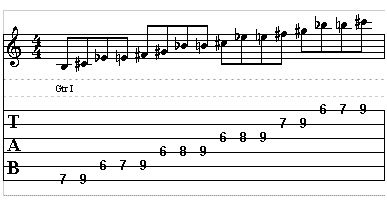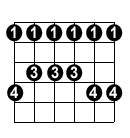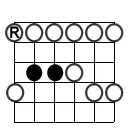Scales are the building blocks of music. They are a sequence of notes that provide a road map for just about everything including chord construction, chord progressions, songwriting, and soloing. Understanding scales is about as essential to a guitarist’s survival as water is to a fish.
In a way, learning scales is kind of like learning what notes go together well when you’re playing in a certain key signature. Knowing the proper scales will give you a foundation to know what lead notes sound good together and which ones don’t.
A lot of people get confused when it comes to scales because most books, magazines, and other instructional material make them out to be more complicated than they really are. In all the world of music there are literally dozens of different types of scales, but learning them all should not be your priority.
The Are Two Types Of Scales
There are two basic types of scales. They are the major scale and the minor scale which each have 7 notes.
There’s a good reason we begin our conversation with the C and Am scales, because they contain no sharps or flats. To play from either the C or Am scale on the piano, all you have to do is play the white keys. The white keys are the 7 primary notes and the 7 primary notes are both the C and Am scale. The black keys are the 5 secondary notes, which are all the sharps and flats. It’s a little bit trickier on the guitar, because we don’t have white or black keys, but more on that later.
![]()
The 1st scale we’ll talk about is the major scale.
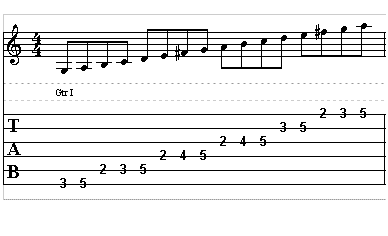
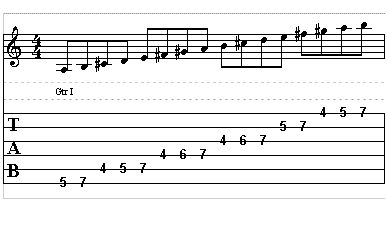
On the other hand…
On the other hand, you don’t need to know scales to play lead guitar, or for that matter, any instrument. A lot of the old blues players claim that they don’t know any scales or theory whatsoever. All you need is an ear to tell you if the notes sound good.
What scales do for you…
Knowing scales does allow you to be able to improvise smoothly
and coherently without sounding like a train wreck. Theory is great, but feel is just as important. Developing both is the tricky part. That said, learn your scales. It will help.
In a way, learning scales is kind of like learning what notes go together well when you’re playing in a certain key. Knowing these scales will give you a foundation to know what lead notes sound good together and which ones don’t.
By now we have a general idea what a scale is, but what is a key signature? What does it unlock, if anything?
Key Signatures
Every song has a key signature.
A Key Signature tells us what originating tone a song is to be performed in.
There are 12 tones of equal value.
Imagine tones as blocks:
| 1 | 2 | 3 | 4 | 5 | 6 | 7 | 8 | 9 | 10 | 11 | 12 |
The distance between each tone is called a half-step interval.
Since there are 12 tones in music, there are 12 major Key Signatures in music. 7 of these are primary key signatures called A, B, C, D, E, F, and G.
The remaining 5 key signatures are secondary key signatures. They have dual names, meaning they can be called sharp or flat. A sharp means half a step higher and a flat mean half a step lower. Sharps are represented by a “#” and flats are represented by a “b”. The 5 secondary key signatures are called G# or Ab, A# or Bb, C# or Db, D#
or Eb, and F# or Gb.
The 12 Key Signatures:
| 1 | 2 | 3 | 4 | 5 | 6 | 7 | 8 | 9 | 10 | 11 | 12 |
| A | A#/Bb | B | C | C#/Db | D | D#/Eb | E | F | F#/Gb | G | G#/Ab |
A key signature can also be a minor key signature which make for a total of 24 key signatures total.
Identifying The Key Of A Song
After reading this page you’ll have a little hands-on experience at determining the key signature of a song. This is a skill you’ll develop with time as you learn more and more about how music works, but you’ll get a firm understanding of what to look for right here, right now.
24 Key Signatures
There are up to 24 possible key signatures. Since there are 12 tones in music, there can be 12 major keys and 12 minor keys.
In the exercise on this page we’re going to practice identifying the key signature of a song. Before you try it, be sure you know the difference between the sound of a major chord and the sound of a minor chord.
Beginning And Ending
Usually the chord that starts a song will tell you what key a song is being played in. Most songs begin and almost always end with the chord that is the same as the key signature. For example if a song begins with an A major chord, then it’s most likely in the key of A major–but especially if it ends with an A major chord as in the case in the audio example below:
Here is the chord progression that was played: A – D – F#/Gbm – E – A
Exceptions
While most songs begin and end with the chord that is the same as their key signature, there are exceptions. Sometimes a song will start on a chord that is not the same as it’s key signature, but the key signature chord will soon follow it. The chord that is the same as the key signature will usually played more than any other chord. Take a listen to the example below:
This song is in the key of F (F major). Yet it begins with an A#/Bb chord. Here’s the first part of the chord progression: A#/Bb – C – F – A#/Bb – C – F. Clearly it ends with an F chord, and usually this is a dead giveaway. But the bridge that comes next leaves no doubt: Am – Dm – Am – Dm – A#/Bb – C – F. It also ends with and F chord. The lesson learned here is that the beginning may be a little vague, but the
ending of a song or chord progression in a song will usually leave no doubt as to what the key signature is.
If a song doesn’t end with the chord that is the same as it’s key signature it usually leaves a feeling of “hanging”. It’s like the song isn’t complete without the key signature chord at the end.
There are songs that end on a chord other than the key signature chord. You can usually spot them a mile away. Some artists
use them to create that incomplete or hanging feeling at the end of a song.
You’ve Got To Train Your Ears
You best bet for learning how to determine a song’s key signature is to practice. In fact, it’s the only way you’ll every truly know. Your ears have to be trained to know what to listen for.
Try listening to the radio with your guitar in hand and try to figure out the key signature for each song that plays. First listen for a major or minor key and then try to determine the name of it’s key.
Using Scale Diagrams
Scale diagrams are like a snapshot of your guitar’s fretboard showing 5 frets. The black dots show the scale pattern as it appears on the fretboard. The numbers in the black dots show what fingers you should use to finger that note when practicing the scale. The white dots at the top are open strings:
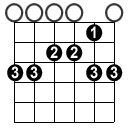
While this may look similar to a chord diagram, it’s not played like a chord. You should practice playing it one note at a time. Start with the lowest note on the low E string and play up the scale until you get to the highest note, then go back down backwards.

Movable Patterns Diagrams
Some scale diagrams don’t show you where to play them on the fretboard, only the pattern. They are movable patterns which means they can be played anywhere on the fretboard depending on what key you are playing in. The first diagram will show the pattern with the suggested fingerings. Look at the example below:
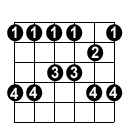
Scale/Chord Relationship
The scale patterns are built around the open position chord that they are named after. The second picture for each scale pattern shows the root and highlights the CAGED chord pattern that the scale pattern is associated with. The white dots and black dots make up the scale pattern, but the black dots show you the chord pattern the pattern is built around. Look at the example below:
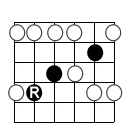
This pattern above is the C scale pattern. With the CAGED chord highlight picture you can see how the scale pattern relates to the C major chord form. Below is a diagram of the C major chord form. Can you see the similarities with the C scale pattern?

Root Notes
You’ll notice that there are 12 different key signatures for each scale.
That doesn’t mean you have to learn the scale 12 separate times. You only need to learn the different scale patterns. You simply have to move the patterns up or down the fretboard in order to change keys. In diagram bellow you can see a visual representation of a pentatonic minor scale pattern. The root note of the scale is marked by an “R”.
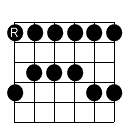
Since the pattern is the same for any key we must simply match the root note to the note on the 6th string that matches the name of the key. See the chart below.
| Fret | 1 | 2 | 3 | 4 | 5 | 6 | 7 | 8 | 9 | 10 | 11 | 12 |
| Key | F | F#/Gb | G | G#/Ab | A | A#/Bb | B | C | C#/Db | D | D#/Eb | E |
As scale pattern can have it’s root note in a different place other than the lowest note. This pentatonic major scale pattern has it’s root note in a place other than the lowest note. It’s the second note on the bottom string as illustrated below:
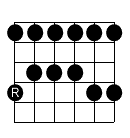
| Fret | 1 | 2 | 3 | 4 | 5 | 6 | 7 | 8 | 9 | 10 | 11 | 12 |
| Chord | – | – | (open) G | G#/Ab | A | A#/Bb | B | C | C#/Db | D | D#/Eb | E |
Since there are 12 different keys signatures you need to know the root of each scale pattern. You will see that each scale pattern shares the same root note as the chord form that is associated with them. The root is marked by a “R” in each chord pattern highlight diagram
for each scale pattern like in the example below:

Playing this scale pattern so that the root falls on the 5th fret it would be playing it in the key of D, because the 5th fret of the 5th string (where the root falls) is D. Here it is tabbed out:

The scale patterns have roots on the 6th, 5th, and 4th strings, so being able to identify notes on these strings is important if you want to be able to play them in all 12 key signatures.
Practicing Scale Patterns With Diagrams
Take a look at the minor scale pattern diagrams below:
Now forget the fancy name and look at the actual pattern. Remember that it is a movable pattern, so we can play this anywhere on the neck of the fretboard depending on what key we want to play in.
As an example let’s say we wanted to practice the scale pattern in the key of G (or Gm). First we would find our root note which would be the G note on the 6th string, because the second diagram above shows us that the root note is on the 6th string (low E). We can either play the G note on the 3rd fret or an octave higher at the 15th fret.
Okay, so we’ve found our root note and are ready to play up and down the scale-each note in sequence from lowest note in the scale to the highest note in the scale and then back down again. This is how it would be played:

See, if we know that the root note is on the 3rd fret, we know the rest of the notes in the scale pattern follow in sequence:

Take a look at scale patterns like this: learning one pattern is like learning 12 scales, because you can play the pattern in 12 keys.
